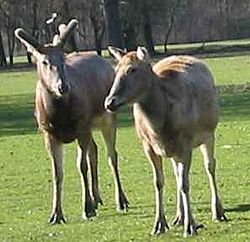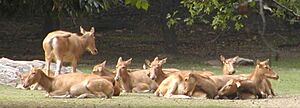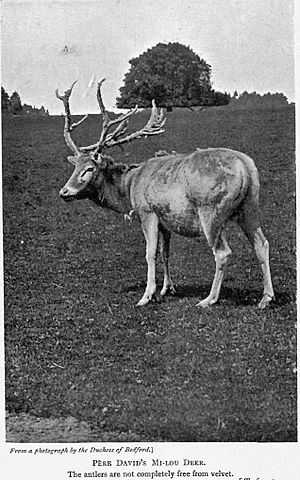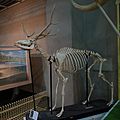Père David's deer facts for kids
Quick facts for kids Père David's deer |
|
|---|---|
 |
|
| Conservation status | |
| Scientific classification | |
| Kingdom: | |
| Class: | |
| Order: | |
| Family: | |
| Subfamily: |
Cervinae
|
| Genus: |
Elaphurus
|
| Binomial name | |
| Elaphurus davidianus Milne-Edwards, 1866
|
|
The Père David's deer (Elaphurus davidianus), also called Milu in Chinese, is a special type of deer. Today, you can only find them in zoos and special reserves. They love living in marshy areas. Scientists believe they originally came from warm, wet places. These deer enjoy eating a mix of grass and plants that grow in water.
Contents
What They Look Like
Adult Père David's deer are quite large. They usually weigh between 150 and 200 kilograms (about 330 to 440 pounds).
These deer have a long tail and wide hooves. Their antlers are branched, meaning they have many points. In summer, their coats are bright red with a dark stripe down their back. In winter, their fur turns a dark gray. Baby deer, called fawns, are born with spots.
Life Cycle
Female Père David's deer are pregnant for about nine months. They usually give birth to one or two fawns at a time. These young deer grow up quickly. They become adults when they are about 14 months old. Père David's deer can live for a long time, sometimes up to 23 years!
Where They Lived and How They Were Saved
The Père David's deer was first made known to Western scientists in 1866. A French missionary named Father Armand David was working in China. He sent deer skeletons and a hide back to Paris.
At that time, the Chinese emperor had a special herd of these deer. They lived in a royal hunting park near Beijing. But in 1895, a big flood damaged the park wall. Many deer escaped. Only about 20 animals were left in the park.
Sadly, during the Boxer Rebellion, soldiers from Western countries and Japan ate the last deer in China. The very last wild Père David's deer was shot in 1939 near the Yellow Sea.
Luckily, some deer had been taken to Europe before this happened. They were put in zoos. After the deer disappeared from China, the remaining 18 deer in Europe were brought to Woburn Abbey in England. Here, they were carefully bred to save their species.
All the Père David's deer alive today come from this small group. You can now find them in zoos all over the world. In the late 1980s, some deer were even brought back to China. They now live in special reserves like Nan Haizi Milu Park in Beijing and Dafeng Reserve in Jiangsu Province. Even though their population started from a very small number, these deer seem to be healthy. They do not have many genetic problems.
In 2008, a group called the ICUN officially listed the Père David's deer as "Extinct in the Wild." This means they no longer live freely in nature, but only in places managed by people.

Images for kids
-
Skeleton of a male deer at Kobe Oji Zoo in Kobe, Japan.
See also
 In Spanish: Ciervo del padre David para niños
In Spanish: Ciervo del padre David para niños









